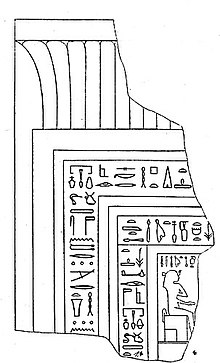Aat (queen)

| ||
| Aat in hieroglyphs | ||
|---|---|---|
| Era: Middle Kingdom (2055–1650 BC) | ||
Aat (“The Great One”) was a queen of the ancient Egyptian 12th Dynasty. Of all the wives of Amenemhat III, only her name is known to modern archaeology with any certainty.[1]
Tomb[edit]
Aat was buried at Dahshur, under her husband's pyramid, along with another queen whose name is lost.[1][2] Her burial chamber is under the south side of the pyramid. The box with the canopic jars was put in a niche above the entrance.[citation needed]
Although the tomb was robbed in antiquity, archaeologists found her sarcophagus, a false door and an offering table[1] along with a few pieces of burial equipment, such as seven alabaster bowls in the form of ducks, two mace heads, pieces of jewelry and one of the canopic jars. Among the burial items of the other queen buried in the adjoining chamber were obsidian and alabaster bowls, granite and alabaster mace heads and some jewels, along with the pieces of a small stone shrine.[citation needed] Aat was about 35 years old at her death, the other queen was about 25. Their bones were found.[2]
Titles[edit]
Aat's titles were: “King's Wife”, “United with the White Crown”.[1]
Family[edit]
She was one of the many wives of Amenemhat lll. She may have been the mother of Sobekneferu.[citation needed]
